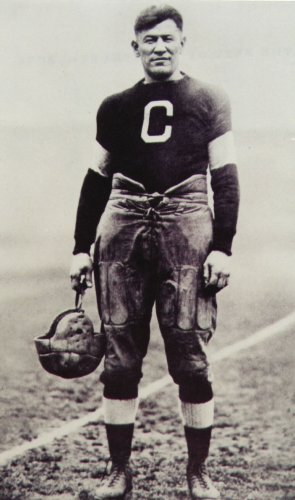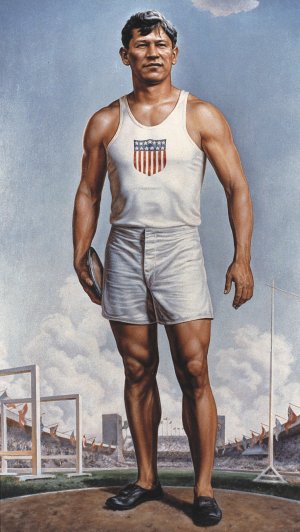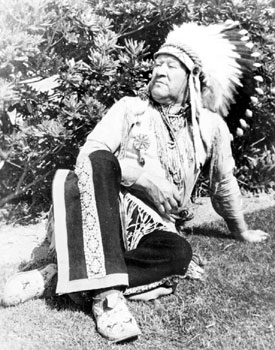5th in series on ethnic firsts in US sports
Who better to be the best US athlete of the 20th Century than a sportsman of melting-pot heritage, child of part Native American, Irish and French parents. In 1950, the Associated Press poll of sports writers named Jim Thorpe as the best American athlete of the first half of the 20th Century. For the second half, the AP named him third, behind Babe Ruth and Michael Jordan.
With all respects, neither Ruth nor Jordan won the Olympic gold in pentathlon and decathlon, and starred in football, baseball and basketball. Nor did Ruth, Jordan or any other such supremely gifted athlete suffer worse abandonment by the sports at which he excelled and the notables who’d lauded him.
Educated in assimilationist Indian Agency schools, Jim Thorpe’s native name was most appropriate: Wa-Tho-Huk or Bright Path. Unfortunately, the trail's end wasn’t.
“Pop” Warner tried to dissuade Thorpe from injuring himself playing football, because Thorpe was already the track-and-field star of Carlisle Indian Industrial School, but the football players were unable to catch up to him. Thorpe even excelled at ballroom dancing, winning the 1912 inter-collegiate ballroom dancing championship. One of the football teams Thorpe almost single-handedly beat was Army’s in 1912. An opposing player, future President Dwight Eisenhower, in 1961 recalled, “Here and there, there are some people who are supremely endowed. My memory goes back to Jim Thorpe. He never practiced in his life, and he could do anything better than any other football player I ever saw.”

At the 1912 Olympics in Stockholm, Thorpe won the gold at the pentathlon and decathlon. A silver medalist observed, “He was the greatest athlete who ever lived….What he had was natural ability. There wasn’t anything he couldn’t do. All he had to see is someone doin’ something and he tried it…and he’d do it better.” Czar Nicholas II presented Thorpe with a special award for the pentathlon, and King Gustav V of Sweden a special award for the decathlon, telling Thorpe, “You, sir, are the greatest athlete in the world. I would consider it an honor to shake your hand.”

Thorpe returned to the US for a ticker-tape parade down Broadway in NYC. Thorpe said, “I couldn't realize how one fellow could have so many friends."
King Gustav and the International Olympic Committee turned out to be the “Indian-givers.” Ignoring its own rules for when a challenge to an Olympic medal may be considered, and ignoring that other college athletes did the same but under aliases, the IOC revoked Thorpe’s medals and took back the Gustav trophy for Thorpe having participated in a few baseball games for pocket-money while in college, voiding his amateur status.
Jim Thorpe then played professional football and baseball, drawing huge crowds. He retired at 41 from pro sports, but continued touring with exhibition teams in football, baseball and basketball.

After his sports career ended, Thorpe found it difficult to find and hold jobs during the Depression. He worked as a laborer, security guard, bouncer, and even as a movie extra as an Indian chief.

By 1950, when diagnosed with cancer, Thorpe was broke. On March 28, 1953, Jim Thorpe -- living in a trailer park -- died from his third heart attack.
Only after his death was the racism and unfairness publicly recognized with which Jim Thorpe was treated. Sports Illustrated’s 2004 retrospective, “Jim Thorpe cruelly treated by authorities", for example, concluded:
Racial prejudice was undoubtedly a factor. Snobbery was another. Brundage [president of the US Olympic Committee, who rebuffed restoring Thorpe’s medals] rigidly adhered to an amateur ethic designed to keep workers in their place which was long out of date by the time of his death in 1975.
Revenge may have been a third. Brundage finished sixth in the pentathlon and 15th in the decathlon behind Thorpe at the 1912 Games.
A teammate of Thorpe’s on the New York Giants recounted Thorpe, in tears, visiting his room, telling him about the taking away of his Olympic medals. “It broke his heart and he never really recovered.”
Hollywood made a movie about him, starring Burt Lancaster, and paid him nothing for being a consultant. A town in Pennsylvania he’d never been in renamed itself after him, to gain tourism dollars. His statue is in the football hall of fame. His Olympic medals were stolen from a museum. In my opinion, the only true honor to Jim Thorpe is the large park in central Flagstaff, Arizona where my kids played every day while we were touring and generations of other kids play for the joy of sports that too many adults forget is what they’re about.
From Wikipedia, Native Wiki, Sports Illustrated





